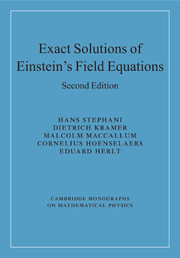Book contents
- Frontmatter
- Contents
- Preface
- List of tables
- Notation
- 1 Introduction
- Part I General methods
- Part II Solutions with groups of motions
- 11 Classification of solutions with isometries or homotheties
- 12 Homogeneous space-times
- 13 Hypersurface-homogeneous space-times
- 14 Spatially-homogeneous perfect fluid cosmologies
- 15 Groups G3 on non-null orbits V2. Spherical and plane symmetry
- 16 Spherically-symmetric perfect fluid solutions
- 17 Groups G2 and G1 on non-null orbits
- 18 Stationary gravitational fields
- 19 Stationary axisymmetric fields: basic concepts and field equations
- 20 Stationary axisymmetric vacuum solutions
- 21 Non-empty stationary axisymmetric solutions
- 22 Groups G2I on spacelike orbits: cylindrical symmetry
- 23 Inhomogeneous perfect fluid solutions with symmetry
- 24 Groups on null orbits. Plane waves
- 25 Collision of plane waves
- Part III Algebraically special solutions
- Part IV Special methods
- Part V Tables
- References
- Index
13 - Hypersurface-homogeneous space-times
from Part II - Solutions with groups of motions
Published online by Cambridge University Press: 10 November 2009
- Frontmatter
- Contents
- Preface
- List of tables
- Notation
- 1 Introduction
- Part I General methods
- Part II Solutions with groups of motions
- 11 Classification of solutions with isometries or homotheties
- 12 Homogeneous space-times
- 13 Hypersurface-homogeneous space-times
- 14 Spatially-homogeneous perfect fluid cosmologies
- 15 Groups G3 on non-null orbits V2. Spherical and plane symmetry
- 16 Spherically-symmetric perfect fluid solutions
- 17 Groups G2 and G1 on non-null orbits
- 18 Stationary gravitational fields
- 19 Stationary axisymmetric fields: basic concepts and field equations
- 20 Stationary axisymmetric vacuum solutions
- 21 Non-empty stationary axisymmetric solutions
- 22 Groups G2I on spacelike orbits: cylindrical symmetry
- 23 Inhomogeneous perfect fluid solutions with symmetry
- 24 Groups on null orbits. Plane waves
- 25 Collision of plane waves
- Part III Algebraically special solutions
- Part IV Special methods
- Part V Tables
- References
- Index
Summary
The possible metrics
This chapter is concerned with metrics admitting a group of motionstransitive on S3 or T3. Some solutions, such as the well-known Taub– NUT (Newman, Unti, Tamburino) metrics (13.49), cover regions of both types, joined across a null hypersurface which is a special group orbit (metrics admitting a Gr whose general orbits are N3 are considered in Chapter 24). As in the case of the homogeneous space-times (Chapter 12) we first consider the cases with multiply-transitive groups. From Theorems 8.10 and 8.17 we see that only G6 and G4 are possible.
Metrics with a G6 on V3
From §12.1, the space-times with a G6 on S3 have the metric (12.9); this always admits G3 transitive on hypersurfaces t = const and the various cases are thus included in (13.1)–(13.3) and (13.20) below. The relevant G3 types are V and VIIh if k = -1, I and VII0 if k = 0, and IX if k = 1.
Of the energy-momentum tensors considered in this book, the spacetimes with a G6 on T3 permit only vacuum and Λ-term Ricci tensors (see Chapter 5). Thus they will give only the spaces of constant curvature, with a complete G10, which also arise with G6 on S3 and those energymomentum types. Metrics with maximal G6 on S3 are non-empty and have an energy-momentum of perfect fluid type: see §14.2.
- Type
- Chapter
- Information
- Exact Solutions of Einstein's Field Equations , pp. 183 - 209Publisher: Cambridge University PressPrint publication year: 2003



